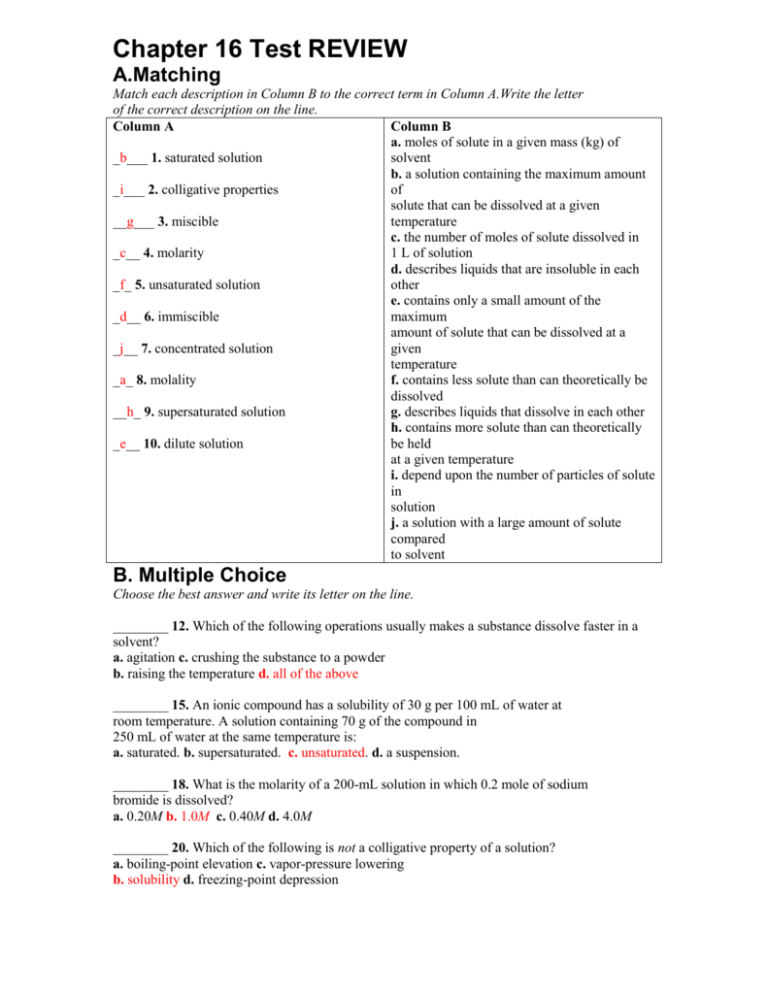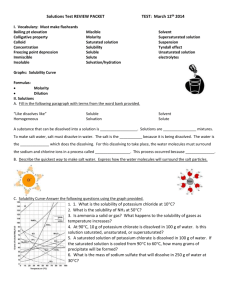KEY
advertisement

Chapter 16 Test REVIEW A.Matching Match each description in Column B to the correct term in Column A.Write the letter of the correct description on the line. Column A Column B a. moles of solute in a given mass (kg) of _b___ 1. saturated solution solvent b. a solution containing the maximum amount _i___ 2. colligative properties of solute that can be dissolved at a given __g___ 3. miscible temperature c. the number of moles of solute dissolved in _c__ 4. molarity 1 L of solution d. describes liquids that are insoluble in each _f_ 5. unsaturated solution other e. contains only a small amount of the _d__ 6. immiscible maximum amount of solute that can be dissolved at a _j__ 7. concentrated solution given temperature _a_ 8. molality f. contains less solute than can theoretically be dissolved __h_ 9. supersaturated solution g. describes liquids that dissolve in each other h. contains more solute than can theoretically _e__ 10. dilute solution be held at a given temperature i. depend upon the number of particles of solute in solution j. a solution with a large amount of solute compared to solvent B. Multiple Choice Choose the best answer and write its letter on the line. ________ 12. Which of the following operations usually makes a substance dissolve faster in a solvent? a. agitation c. crushing the substance to a powder b. raising the temperature d. all of the above ________ 15. An ionic compound has a solubility of 30 g per 100 mL of water at room temperature. A solution containing 70 g of the compound in 250 mL of water at the same temperature is: a. saturated. b. supersaturated. c. unsaturated. d. a suspension. ________ 18. What is the molarity of a 200-mL solution in which 0.2 mole of sodium bromide is dissolved? a. 0.20M b. 1.0M c. 0.40M d. 4.0M ________ 20. Which of the following is not a colligative property of a solution? a. boiling-point elevation c. vapor-pressure lowering b. solubility d. freezing-point depression C. True-False Classify each of these statements as TRUE or FALSE. False (only a few exceptions)__ 22. The solubility of a solute can be increased by cooling the solvent. _true_ 23. Grinding a solute increases the rate at which it dissolves. _true___ 24. As an open bottle of a carbonated beverage warms, the concentration of dissolved carbon dioxide decreases _false__ 27. As the temperature of a solvent increases, the solubility of a gaseous solute increases. (solubility of a gas decreases as temp increases) __true__ 30. A saturated solution has a large amount of solute compared to solvent. . D. Problems Solve the following problems in the space provided. Show your work. 33. Calculate the molarity of a solution prepared by dissolving 95.5 g of KNO3 in enough water to make 750 mL of solution. 95.5 gx 1mole 0.945 moles 101.11g M= molessolut e 0.945moles 1.26M litersolut ion 0.750 L 36. How many grams of Na2SO4 must be added to water to create 750ml of a 2.50M solution? xmole x = 1.875 moles 0.750 L 142.05 g 1.87 mx 266 grams 1mole 2.50 M 37. Calculate the molality of a solution prepared by dissolving 175 g of KNO3 in 1250 g of water. . 175 gx 1mole molessolut e 1.73moles 1.73mol Molality = 1.384m 101.11g kgsolvent 1.25kg 38. Using the data table below, a) which of the compounds is most soluble at 25ºC? KI b) Which of the coumponds has the lowest solubility at 90 ºC? Ce2(SO4)3 c) How many grams of KCl can be dissolved in 200 g of water at 90 ºC? 104 g (can dissolve 52g in every 100g of water, and we have 200 g water so multiply by 2)







